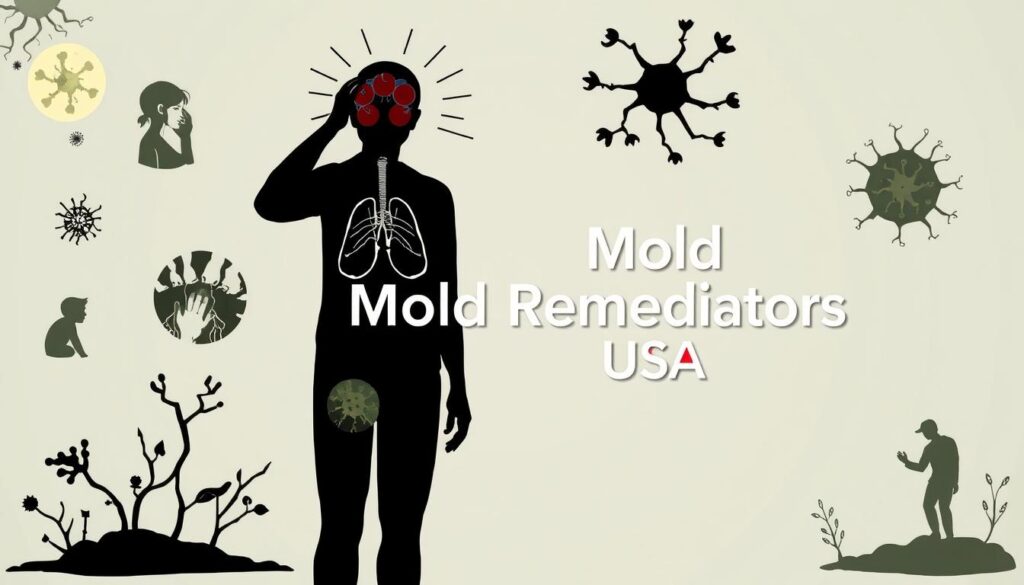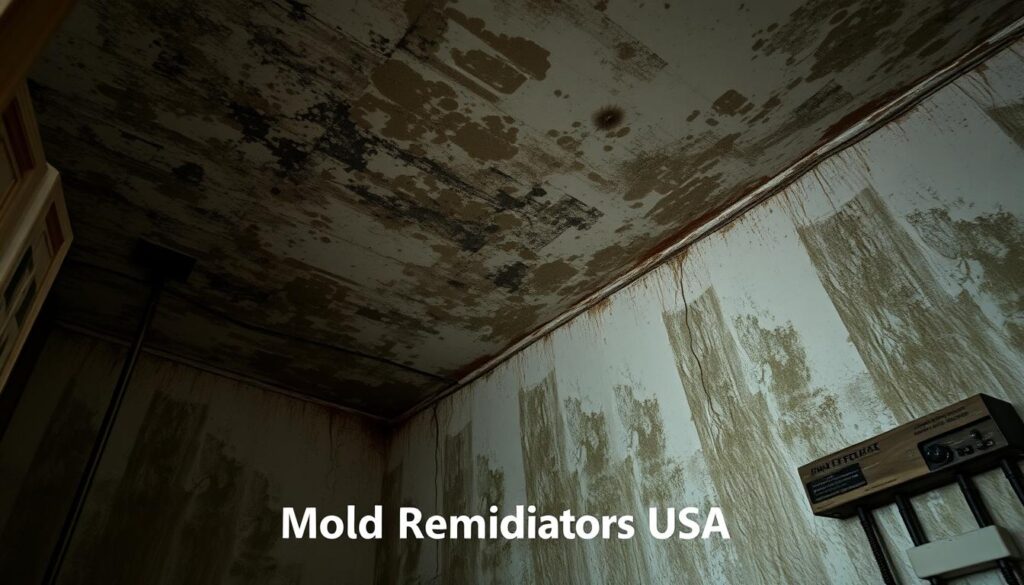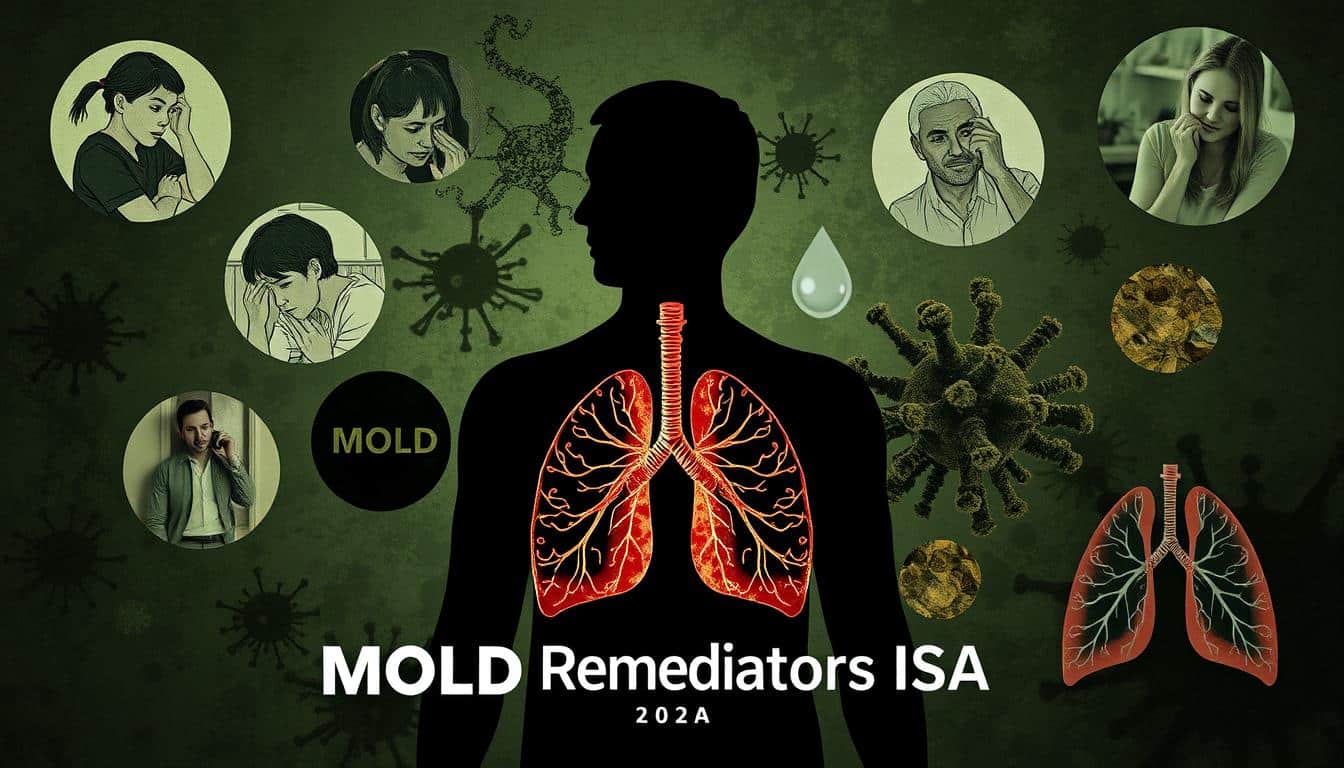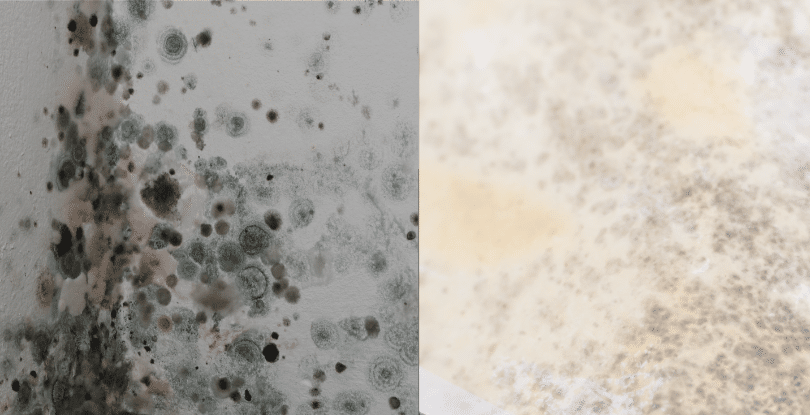Did you know mold spores are everywhere, even in your home? They can grow on any surface with enough moisture. This fact shows how important it is to know about mold toxicity and its health effects. I’ve looked into mold illness symptoms and toxic mold exposure to share important info with you.
Mold in our homes is more than just a cosmetic problem. It can cause serious health issues, especially for those with allergies or weak immune systems. To avoid health problems from mold, we need to find and control moisture sources in our homes. Knowing where moisture comes from, like roof leaks or indoor plumbing issues, is the first step to keeping our health safe from mold poisoning.
When we talk about mold toxicity signs, it’s important to remember that mold affects people differently. Your reaction to mold can range from mild allergies to serious health problems, based on your sensitivity and how much you’re exposed to. By spotting these signs early, we can quickly fix mold problems and keep our health safe.
Key Takeaways
- Mold spores are present everywhere, including our homes
- Moisture control is crucial for preventing mold growth
- Mold can cause various health issues, from allergies to respiratory problems
- Individual reactions to mold exposure vary widely
- Early recognition of mold toxicity signs is vital for prompt action
- Proper remediation is necessary to address mold issues effectively
Understanding Mold and Its Impact on Health
Mold is a common problem in homes that can harm our health. I’ve done a lot of research to explain what mold is, where it grows, and how it affects us.
What is mold?
Mold is a fungus that grows in damp places. It spreads through tiny spores that float in the air. These spores land on surfaces where it’s moist, causing mold to grow. While mold is important in nature, it can be dangerous indoors.
Common types of mold in homes
Many types of mold can be found in homes. These include Cladosporium, Penicillium, Aspergillus, Alternaria, and black mold (Stachybotrys chartarum). Each type can grow on different materials like fabrics, wood, paper, and dust.
How mold affects human health
Mold can cause health problems. For people with allergies, mold can make them sneeze and have a runny nose. It can also make asthma worse or even cause asthma in some people.
Black mold’s toxins are a big worry, but studies are still looking into their effects. People with weak immune systems or breathing problems are at higher risk from black mold.
To stay healthy, keep your home’s humidity low and fix any water damage fast. If you think you have mold, get a professional to remove it safely.
Recognizing Mold Growth in Your Environment
Mold can sneak into our homes without us noticing. It’s important to spot mold early to avoid health problems. Let’s learn how to find mold and where it likes to hide.
Visual Signs of Mold Infestation
Mold shows up as fuzzy, colored patches on surfaces. These can be black, green, or pink. FEMA and CDC say to watch for wall or ceiling stains and musty smells. If you smell damp earth, check it out.
Identifying Hidden Mold Growth
Hidden mold is harder to find but just as harmful. It can hide behind wallpaper, under carpets, or inside walls. Unexplained allergies or breathing problems might mean hidden mold is present. It’s crucial to check these areas, especially after water damage. Mold can grow in 24 to 48 hours after water exposure.
Common Areas Prone to Mold Growth
Some areas in our homes are more likely to have mold. This is because they are moist and don’t get enough air. Almost half of U.S. homes have mold, often in these places:
- Bathrooms (especially around showers and tubs)
- Kitchens (under sinks and behind appliances)
- Basements and crawl spaces
- Attics with poor ventilation
- Window sills and frames
Mold loves damp places with little air. It often grows under ceiling tiles, flooring, and carpet where it’s moist and not well-ventilated. Keeping indoor humidity between 40% and 60% helps prevent mold.
Spotting mold early is crucial to stop it from spreading. Regular checks and quick action can keep our homes safe and healthy.
The Science Behind Mold Toxicity
Mold toxicity comes from mycotoxins, harmful substances made by some molds. These can cause long-term inflammation in our bodies, leading to health issues. I’ve looked into the research to see how mycotoxins affect our health.
Research shows that people exposed to mold spores might have different immune responses than those not exposed. These immune responses can either fight or cause inflammation. This difference might explain why some people get sick from mold more easily.
It’s hard to diagnose and treat mold toxicity because people react differently to mycotoxins. Tests for mold exposure can be unreliable, and many aren’t covered by insurance. This makes it hard to agree on mold toxicity in the medical field.
Studies suggest that many people are exposed to mycotoxins. A study found that 35% of cases involve mycotoxins and their health effects. What’s even scarier, 60% of workplaces have toxic fungi and mycotoxins, affecting workers’ health.
| Setting | Mycotoxin Prevalence |
|---|---|
| General Occurrences | 35% |
| Workplaces | 60% |
| French Infant Diet | 45% |
| Spanish Children (Plasma) | 20% |
Mycotoxins can cause long-term inflammation, affecting people in different ways. For example, 90% of asthmatic patients react to common mold species, showing mold’s big impact on breathing. These findings highlight the need for more research on mycotoxins and their role in chronic diseases.
What Are Signs of Mold Toxicity?
I’ve learned that mold toxicity can show up in many ways, affecting different parts of our body. It’s important to know these signs early to treat mold illness symptoms.
Respiratory Symptoms
Mold can first hit our respiratory system. People might feel short of breath, have a chronic cough, or experience sinus congestion. Those with asthma might find these symptoms even worse.
Neurological Symptoms
Toxic mold can mess with our brain. Symptoms include memory loss, trouble focusing, and feeling foggy. Headaches, migraines, and being sensitive to light and touch are also signs.
Skin-related Symptoms
Skin irritation is a clear sign of mold toxicity. Rashes and hives can show up, especially in people with sensitive skin or allergies.
Gastrointestinal Issues
Mold can also mess with our stomach. Symptoms include stomach pain, diarrhea, and nausea.

It’s key to remember that mold toxicity can look like other conditions. People with mold illness are often wrongly diagnosed with chronic fatigue syndrome, rheumatoid arthritis, or fibromyalgia9. If you’re feeling unwell and think it might be mold, see a doctor.
| System Affected | Common Symptoms |
|---|---|
| Respiratory | Shortness of breath, chronic cough, sinus congestion |
| Neurological | Memory problems, difficulty concentrating, headaches |
| Skin | Rashes, hives, skin irritation |
| Gastrointestinal | Abdominal pain, diarrhea, nausea |
Differentiating Mold Allergies from Mold Toxicity
Mold allergies and mold toxicity can be hard to tell apart. Mold allergies cause quick reactions like sneezing and itchy eyes. Mold toxicity, from long-term exposure to mycotoxins, leads to more serious health problems.
Mold IgE testing can show allergic reactions to specific mold species. But, it can’t detect non-allergic reactions or toxicity levels. Mycotoxin testing, using mass spectrometry or ELISA, can find toxins in urine or tissue. This gives a detailed look at mold exposure risks.
People with allergies, asthma, or weak immune systems are at higher risk. Exposure to damp, moldy spaces can cause coughing and wheezing even in healthy folks. In rare cases, mold exposure might link to memory loss or lung bleeding, though this isn’t proven.
Mold poisoning and biotoxin illness are often mistaken for other conditions. Symptoms without clear causes might be labeled as sick building syndrome or dampness and mold hypersensitivity syndrome. These can include headaches, fatigue, and respiratory issues.
| Aspect | Mold Allergy | Mold Toxicity |
|---|---|---|
| Onset | Immediate | Gradual |
| Duration | Short-term | Long-term |
| Symptoms | Sneezing, itchy eyes | Varied systemic issues |
| Testing | Mold IgE Testing | Mycotoxin Testing |
To prevent mold issues, keep humidity between 30% and 50%, improve ventilation, and use air purifiers. If you spot mold, report it quickly and clean it carefully to avoid further exposure. Remember, addressing both the mold and its moisture source is key to effective removal.
Risk Factors for Developing Mold-Related Health Issues
Some factors can raise your risk of health problems from mold. Let’s look at the main risk factors for mold toxicity and its health effects.
Pre-existing Health Conditions
Those with allergies, asthma, or weak immune systems face higher mold risks. Infants in moldy homes are three times more likely to get asthma by age 7. Kids exposed to mold in school have more asthma symptom days than those not exposed.
Environmental Factors
Your living or work environment affects mold exposure. Poor air, water damage, and high humidity boost mold growth. Low-income homes often have more mold due to leaks. Climate change can also increase indoor mold due to extreme weather.

Genetic Predisposition
Some people are genetically more sensitive to mold. This can cause a chronic inflammatory response or sick building syndrome when exposed to mold spores.
| Risk Factor | Impact on Mold Sensitivity |
|---|---|
| Pre-existing Health Conditions | Increased susceptibility to mold-related symptoms |
| Environmental Factors | Higher exposure to mold spores and growth |
| Genetic Predisposition | Enhanced sensitivity to mold toxins |
Knowing these risk factors helps protect your health. If mold concerns you, talk to a healthcare expert. They can assess your risk and help prevent mold exposure.
Diagnosing Mold Toxicity: Tests and Procedures
Figuring out if you have mold toxicity can be hard. Let’s look at some tests and procedures to spot black mold health risks and help with mycotoxin detox.
Blood tests are a good, painless way to find out if you’ve been exposed to mold. They can tell if you have genes that make it hard to get rid of mold or biotoxins.
Skin prick tests can also check for mold sensitivity, but they might not always be right. Nasal swabs are a gentle way to check for mold spores in your nose.
Urine tests can show mycotoxin levels. In fact, 93% of people with Chronic Fatigue Syndrome had mycotoxins in their urine. This test is important for a good detox plan.
“Awareness of toxic mold’s effects has increased dramatically in recent years.”
Getting your home checked by a certified mold inspector is crucial. About 43% of buildings have water damage now, and 85% have had it before. These checks can find hidden mold risks in your home.
| Test Type | Pros | Cons |
|---|---|---|
| Blood Test | Reliable, Non-invasive | May not identify all mold types |
| Skin Prick Test | Identifies mold allergies | Potential false results |
| Urine Test | Measures mycotoxin levels | Results can vary |
| Home Inspection | Identifies environmental sources | May miss hidden mold |
It’s important to use a mix of tests and symptoms for a correct diagnosis. If you think you’ve been exposed to mold, talk to a doctor for the right diagnosis and treatment.
The Controversial Nature of Mold Toxicity in Medicine
Mold toxicity is a big topic in medicine. Doctors don’t always agree on its effects on health. This makes it hard for patients to get the right care.
Current Medical Perspectives
The medical community is divided on mold toxicity. Some doctors believe it’s a real threat, while others are unsure. The World Health Organization says 10% to 50% of indoor spaces in many countries have serious mold issues.
This shows how big the problem might be.
Challenges in Diagnosis and Treatment
Diagnosing mold toxicity is hard. Symptoms can look like other health problems. This makes it hard for doctors to find the cause.
A study found that 67% of adult-onset asthma cases started after working in moldy buildings. This link between mold and health issues is clear, but treating it remains a challenge.
Ongoing Research and Developments
Scientists are working hard to understand mold toxicity better. Recent studies show that mold exposure can cause pain, fatigue, anxiety, depression, and memory problems. This research helps explain why people living in moldy homes often feel unwell.
| Health Issue | Percentage Increase |
|---|---|
| Asthma and related problems | 30% to 50% |
| Contribution to US asthma cases | 21% |
These numbers show how mold affects our health. The chronic inflammatory response and biotoxin illness from mold exposure are real concerns. As research continues, I hope we’ll find better ways to diagnose and treat these conditions.
New studies on mice reveal that mold exposure can decrease brain cell growth and cause memory problems. This research might help explain why some people with mold exposure have trouble thinking clearly. It’s a step towards understanding the full impact of living or working in moldy buildings.
Prevention Strategies: Keeping Your Home Mold-Free
Preventing mold growth is key to avoiding sick building syndrome and mold illness symptoms. It’s all about controlling moisture and improving air flow. Keep indoor humidity below 60%, aiming for 30% to 50%. Use dehumidifiers in damp areas like basements or crawl spaces to stop mold.
Good air flow is vital, especially in places like bathrooms and kitchens. Make sure you have working exhaust fans and clear attic vents to reduce moisture. Fix water damage quickly – mold needs 72 hours to grow. Regular checks in mold-prone spots can catch problems early.
Keep your home’s outside in good shape to stop water from getting in. Use better roofing, protect your foundation, and install weather barriers. Make sure your yard slopes away from your house and clean your gutters to avoid water buildup. These steps are key to stopping mold and keeping your home healthy.
| Area | Prevention Strategy |
|---|---|
| Bathrooms | Use exhaust fans, fix leaks promptly |
| Basements | Use dehumidifiers, check for water intrusion |
| Attics | Ensure proper ventilation, inspect for leaks |
| Kitchen | Use exhaust fans when cooking, clean spills immediately |
Preventing mold is simpler than fixing it. By tackling moisture issues, you protect your health and home. Always watch for signs of too much moisture or mold and deal with them fast to keep your home safe.
Treatment Options for Mold Toxicity Symptoms
Dealing with toxic mold exposure needs a full plan. I’ll show you the different ways to handle mold toxicity symptoms and help with mycotoxin detox.
Medical Interventions
Doctors might give antifungal meds like voriconazole for bad mold reactions. These drugs fight fungal infections and ease symptoms. Sometimes, they suggest immunotherapy to help your body fight mold allergens better.
Environmental Remediation
Fixing the source is key. Studies say up to 50% of homes have mold. To tackle this, I suggest:
- Thorough cleaning and removing visible mold
- Fixing water leaks and lowering humidity
- Improving air flow in mold-prone spots
- Using mold-resistant stuff in home fixes
Lifestyle Changes and Natural Remedies
Changing your lifestyle is vital for getting better from mold toxicity. Here are some good tips:
| Strategy | Benefit |
|---|---|
| Low-mold diet | Lessens mold intake from food |
| Air purifiers | Cleans mold spores from air |
| Regular exercise | Strengthens immune system |
| Stress reduction | Helps health and detox |
Some people talk about “mold detox” treatments, but there’s no proof they work. Instead, focus on keeping your body healthy with a good diet, enough water, and exercise.
Mold toxicity can mess with almost every body system. If you’re dealing with mold symptoms, see a doctor for help and advice.
Conclusion
Mold toxicity is a big health issue for many. It can cause breathing problems like coughing and wheezing. It also affects the brain, leading to foggy thinking and memory loss.
How mold affects people varies. It depends on their immune system and the type of mold.
Spotting mold toxicity early is crucial. Look out for skin issues, feeling tired, and stomach problems like nausea. If you think you’ve been exposed, see a doctor right away.
Doctors might run tests like urine and blood tests to find mold toxicity.
Stopping mold before it starts is key. Check your home often, fix leaks fast, and make sure it’s well-ventilated. If you find mold, get a pro to clean it up.
Treatment for mold effects can include medicine and changing your lifestyle. You might also need detox methods. By being aware and taking action, we can keep ourselves and our families safe from mold dangers.
FAQ
What are the signs of mold toxicity?
Signs of mold toxicity include respiratory issues like coughing and wheezing. You might also experience brain fog and memory problems. Skin issues like rashes and itching are common, as are stomach problems.
Other signs include unexpected weight changes and numbness in your limbs. You might also feel dizzy, have ringing in your ears, or feel mood swings.
What is the difference between mold allergies and mold toxicity?
Mold allergies cause immediate reactions like sneezing and itchy eyes. Mold toxicity, however, is a result of long-term exposure to toxins. It can lead to more serious health problems.
What factors can increase the risk of developing mold-related health issues?
Certain health conditions, like allergies or asthma, can raise your risk. So can living in damp or poorly ventilated buildings. Genetic factors also play a role.
How is mold toxicity diagnosed?
Diagnosing mold toxicity is tricky. Doctors might use urinalysis or sputum cultures. Home inspections by certified inspectors are also common.
But, test results can be unreliable. So, doctors look at symptoms and test results together.
Why is mold toxicity a controversial topic in medicine?
Mold toxicity is debated because of limited research and no clear diagnostic criteria. Some doctors believe in its health effects, while others are skeptical. Symptoms can be similar to other conditions.
How can you prevent mold growth in your home?
To stop mold, control moisture and improve air flow. Fix water damage quickly and check for mold regularly. Keep your HVAC system, dehumidifiers, and air purifiers in good shape.
What are the treatment options for mold toxicity symptoms?
Treatment involves several steps. Doctors might prescribe medications or recommend environmental changes. This includes removing mold and using air purifiers.
Changing your diet and using natural remedies can also help. Always do this under a doctor’s guidance.




